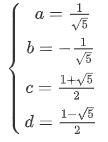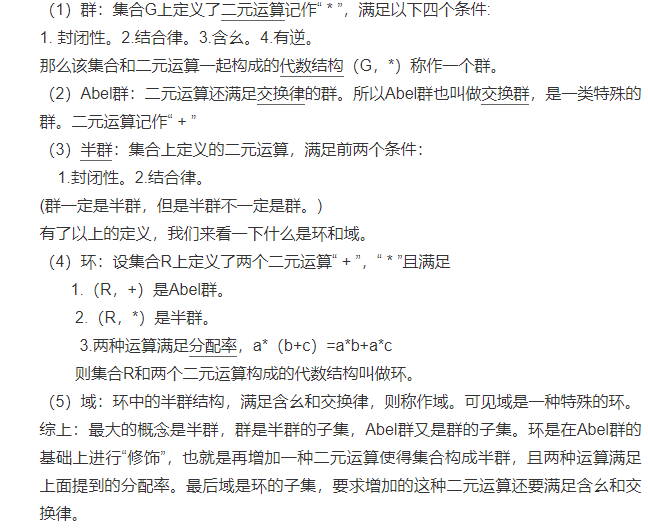斐波那契通项公式
来自https://www.zhihu.com/question/25217301/answer/158753864
(F(x)=x+x^2+2x^3+3x^4+4x^5+...=frac{x}{1-x-x^2})
设(F(x)=frac{a}{1-cx}+frac{b}{1-dx}),可以列出方程

根据③④可以解得

那么把(F(x))展开可得
(F(x)=sum (ac^i+bd^i)x^i)
(F_n=ac^n+bd^n=frac{1}{sqrt5}[(frac{1+sqrt5}{2})^n-(frac{1-sqrt5}{2})^n])
群论
基础定义:
https://www.cnblogs.com/nosta/p/9444576.html
https://blog.csdn.net/Fredric_2014/article/details/84251441
https://blog.csdn.net/Fredric_2014/article/details/84251441
https://wenwen.sogou.com/z/q736604849.htm
https://zhidao.baidu.com/question/92977832.html
https://en.wikipedia.org/wiki/Field_(mathematics)
https://en.wikipedia.org/wiki/Algebraic_number_field
将就看一下吧(
一个域大概就是一个集合加上运算符,满足交换律集合率分配律逆元之类的,操作后的元素一定在范围内



并不知道学了一天学了什么东西
二次剩余
判断
求(x^2equiv n(mod;p))的一组解,即对n开根
定义勒让德符号((frac{n}{p})=n^{frac{p-1}{2}}(mod;p)),特判掉p|n
结论:((frac{n}{q})=1)是二次剩余,(=-1)不是二次剩余
证明:
首先由于(n^{p-1}equiv 1),所以(n^{frac{p-1}{2}}equiv 1;or;-1)
①当n是二次剩余时
那么(sqrt n=n^{frac{1}{2}})有值,则(n^{frac{p-1}{2}}equiv 1)
②当n不是二次剩余时
((p-1)!)除掉1和p-1之后可以两两配对都为1(除掉1和-1之后逆元不等于自己,p^2-1=0)
所以((frac{n}{p})=-1)
计算
首先随机一个(a)使得(w=a^2-n,(frac{w}{p})=-1),由于一个平方对应两个解所以只有一半的数是/不是二次剩余,因此期望次数为2
因为ω太难写了所以就用w代替
定义域(F_p=({0,1,...,p-1})),里面有四则运算,除就是乘以逆元
定义扩域(F_{p2}={a+bsqrt w:x,yin F_p}),同样满足四则运算(类似虚数的操作),a和b都是模p意义下的整数(Fp里的)
证明一下逆元,即求(ω即√w)

解得

那么证得(F_{p2})是一个域
答案即为((a+sqrt w)^{frac{p+1}{2}})在(F_{p2})下的实数部分,另一个解显然是-x
证明(以下操作均在(F_{p2})中进行):
(x=(a+sqrt w)^{frac{p+1}{2}},x^2=(a+sqrt w)^{p+1})
(=(a+sqrt w)^p(a+sqrt w))
二项式展开,根据lucas定理可以提出来一个C(0,>0)的组合数,所以组合数为0
(至于为什么可以模掉,正常来说没有整数乘实数再取模的操作,但这是在扩域下的运算所以可以)
(=(a^p+sqrt w^p)(a+sqrt w))
(=(a+sqrt w^{p-1}sqrt w)(a+sqrt w))
(=(a+(frac{w}{p})sqrt w)(a+sqrt w))
(=(a-sqrt w)(a+sqrt w))
(=a^2-(a^a-n))
(=n)
证毕,得到的是在(F_{p2})域下的解
根据拉格朗日定理(数论中的,不是群论的神仙东西),任意非0n次多项式在任何域下只有最多n个解,而(x^2equiv n(mod;p))在(F_p)中有2个解,在(F_{p2})中显然也是这2个解,所以((a+sqrt w)^{frac{p+1}{2}})没有虚数部分,实数部分就是答案
那么就做完了,时间复杂度O(log)
例题
http://acm.hdu.edu.cn/showproblem.php?pid=6755
强行二合一
模10^9+9意义下5是二次剩余
code
#include <bits/stdc++.h>
#define fo(a,b,c) for (a=b; a<=c; a++)
#define fd(a,b,c) for (a=b; a>=c; a--)
#define C(n,m) (jc[n]*Jc[m]%1000000009*Jc[(n)-(m)]%1000000009)
#define mod 1000000009
#define Mod 1000000007
#define two 500000005
#define ll long long
#define N 5
//#define file
using namespace std;
ll jc[100001],Jc[100001],w[100001],S1[100001],S2[100001],W,n,c,ans,five,s1,s2,s;
int T,K,i,j,k,l;
struct type{ll x,y;};
type operator + (type a,type b) {return {(a.x+b.x)%mod,(a.y+b.y)%mod};}
type operator - (type a,type b) {return {(a.x-b.x)%mod,(a.y-b.y)%mod};}
type operator * (type a,type b) {return {(a.x*b.x+a.y*b.y%mod*W)%mod,(a.x*b.y+a.y*b.x)%mod};}
ll qpower(ll a,ll b) {ll ans=1; while (b) {if (b&1) ans=ans*a%mod;a=a*a%mod;b>>=1;} return ans;}
ll random(int x,int y) {return (1ll*rand()*233333+rand())%(y-x+1)+x;}
ll ldr(int t) {return qpower(t,(mod-1)/2);}
void work()
{
static type A,B;
ll a;
do{
a=random(0,mod-1);W=((a*a-N)%mod+mod)%mod;
} while (ldr(W)==1);
A={1,0},B={a,1};
i=(mod+1)/2;
while (i)
{
if (i&1) A=A*B;
B=B*B;i>>=1;
}
five=A.x;
}
ll js(ll p) {if (p==1) return (n+1)%mod; return (qpower(p,(n+1)%(mod-1))-1)*(qpower(p-1,Mod))%mod;}
int main()
{
#ifdef file
freopen("hdu6755.in","r",stdin);
#endif
srand(time(NULL));
work();
jc[0]=jc[1]=Jc[0]=Jc[1]=w[1]=1;
fo(i,2,100000) w[i]=mod-w[mod%i]*(mod/i)%mod,jc[i]=jc[i-1]*i%mod,Jc[i]=Jc[i-1]*w[i]%mod;
scanf("%d",&T);
for (;T;--T)
{
scanf("%lld%lld%d",&n,&c,&K);ans=0;
s1=(1ll+five)*two%mod,s2=(1ll-five)*two%mod;
s1=qpower(s1,c%(mod-1)),s2=qpower(s2,c%(mod-1));
S1[0]=S2[0]=1;
fo(i,1,K) S1[i]=S1[i-1]*s1%mod,S2[i]=S2[i-1]*s2%mod;
fo(i,0,K)
{
s=S1[i]*S2[K-i]%mod;
ans=(ans+js(s)*C(K,i)*(((K-i)&1)?-1:1))%mod;
}
printf("%lld
",(ans+mod)%mod*qpower(five,(mod-1)-K)%mod);
}
fclose(stdin);
fclose(stdout);
return 0;
}
参考资料
https://www.zhihu.com/question/25217301/answer/158753864
https://www.cnblogs.com/nosta/p/9444576.html
https://blog.csdn.net/Fredric_2014/article/details/84251441
https://zhidao.baidu.com/question/92977832.html
https://wenwen.sogou.com/z/q736604849.htm
https://en.wikipedia.org/wiki/Algebraic_number_field
https://en.wikipedia.org/wiki/Field_(mathematics)
https://en.wikipedia.org/wiki/Lagrange%27s_theorem_(number_theory)
https://blog.csdn.net/Clove_unique/article/details/53149356
https://en.wikipedia.org/wiki/Lagrange%27s_theorem_(group_theory)(似乎并没有什么关系)
https://en.wikipedia.org/wiki/Quadratic_residue#Complexity_of_finding_square_roots
https://en.wikipedia.org/wiki/Cipolla%27s_algorithm
https://blog.csdn.net/skywalkert/article/details/52591343
https://blog.csdn.net/qq_43649416/article/details/106340787
https://www.cnblogs.com/jz-597/p/12796876.html
https://blog.csdn.net/stevensonson/article/details/85845334
https://blog.csdn.net/code92007/article/details/98104873